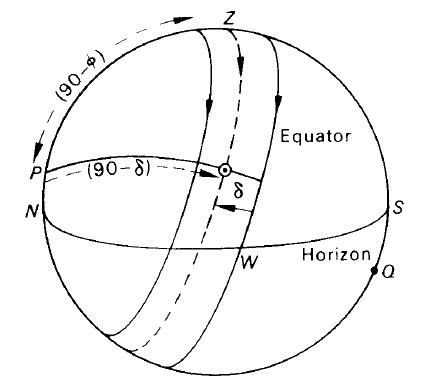
The Earth’s geographical zones
 المؤلف:
A. Roy, D. Clarke
المؤلف:
A. Roy, D. Clarke
 المصدر:
Astronomy - Principles and Practice 4th ed
المصدر:
Astronomy - Principles and Practice 4th ed
 الجزء والصفحة:
p 101
الجزء والصفحة:
p 101
 28-7-2020
28-7-2020
 2296
2296
The Earth’s geographical zones
We can now understand readily why the Earth’s surface is divided into the well-known zones indicated in figure 1 by parallels of latitude 23◦ 26' and 66◦ 34' north and south of the equator; also why zones and parallels are named in the way they are. Within the Torrid Zone, bounded by the Tropics of Cancer and Capricorn, an observer has the Sun in the zenith, or very nearly so, on two days of the year.

Figure 1. The geographical zones.
If the observer’s latitude is numerically less than 23◦ 26' (the obliquity of the ecliptic ε and the maximum declination of the Sun), there will be two occasions each year when
90 − ∅ = 90 − δ
where δ is the Sun’s declination (see figure 2).
The limiting cases are when the observer’s latitude is 23◦ 26' N (Tropic of Cancer) and 23◦ 26' S (Tropic of Capricorn). In order that the Sun should pass through the zenith of an observer in latitude 23◦ 26' N, it must have its maximum northerly declination—this occurs about June 21st when the Sun

Figure 2. The conditions for the Sun being overhead.

Figure 3. The conditions for the midnight Sun and Polar night.
is in Cancer. Similarly, for an observer in latitude 23◦ 26' S, the Sun must have its maximum southerly declination to pass through the zenith—this occurs about December 21st when the Sun is in Capricorn. Within the zone bordered by the Arctic Circle (latitude 66◦ 34' N) and including the North Pole, the Sun will remain below the horizon for at least 24h at some part of the year and at another part six months later, will be above the horizon for at least 24h.
When the latitude ∅ is greater than 66◦ 34' N, the maximum northerly (AB) and maximum southerly (CD) parallels of declination of the Sun are, respectively, entirely above and below the horizon, as seen in figure 3.
Consider the Sun’s declination to be positive. Now, ∠NWL = 90 − ∅, so that the critical declination of the Sun at which it will remain above the horizon and not set is δc N, given by
δc N = 90 − ∅.
Hence, the period of the year during which the Sun’s declination δ has values
δc N ≤ δ ≤ 23◦ 26' N
is the period during which the Sun never sets even at midnight. This is the phenomenon known as the midnight Sun. It is obvious that June 21st will lie at the middle of this period.
It is easily seen from figure 3 that while the Sun’s declination has values between δc S and 23◦ 26' S, the Sun will remain below the horizon. Again, the numerical value of δc S is given by
δc = 90 − ∅.
This period of time when the Sun does not rise, known as the polar night, is around December 21st, the winter solstice in the northern hemisphere.
Obviously for a person in latitudes further south than the Antarctic Circle (66◦ 34' S), corresponding phenomena are observed, though the date halfway through the period of the midnight
Sun will be December 21st; the date June 21st will lie at the middle of the time interval during which the Sun is never seen.
At the North and South Poles, the observer experiences six-month periods with the Sun continuously above the horizon alternating with six-month periods when the Sun is below, neither rising nor setting.
 الاكثر قراءة في مواضيع عامة في علم الفلك
الاكثر قراءة في مواضيع عامة في علم الفلك
 اخر الاخبار
اخر الاخبار
اخبار العتبة العباسية المقدسة


